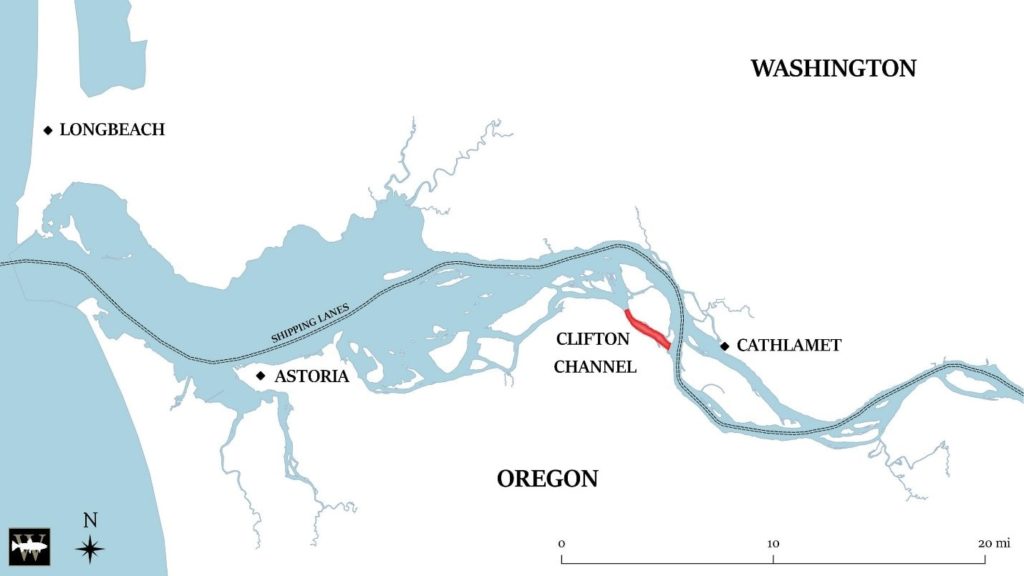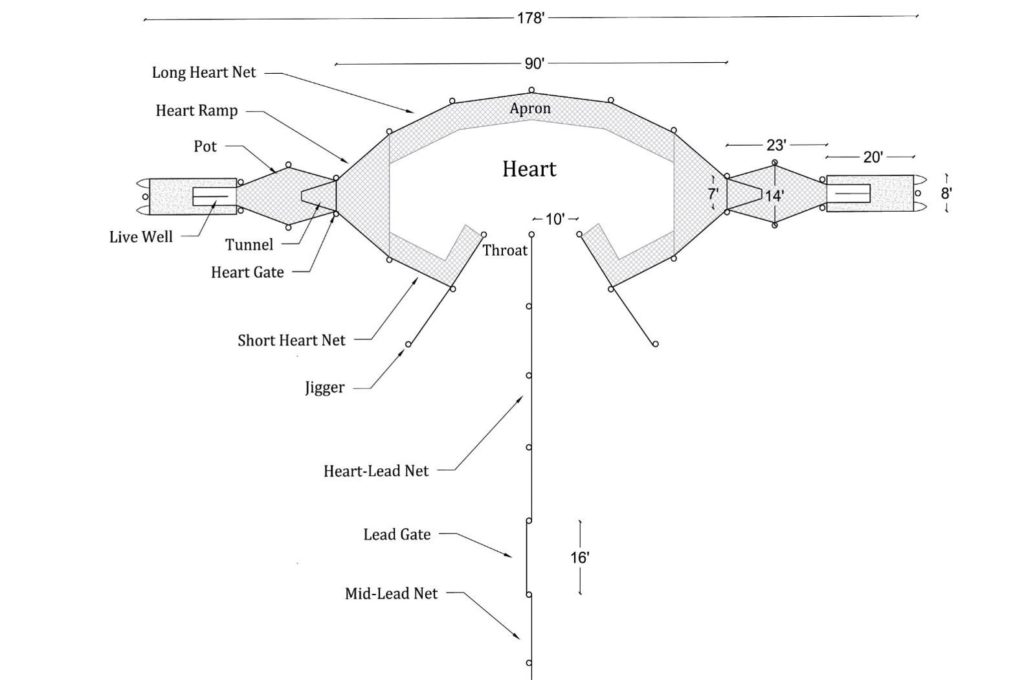Wild Fish Conservancy (WFC) is pleased to announce the beginning of a new adventure on the lower Columbia River! This winter, pilings were driven in a new location on the Oregon-side of the river, providing the structure for what will be a new fish trap research project this coming summer. This important project will investigate additional means to reduce commercial fishery bycatch impacts to wild salmonids with alternative gear, thereby improving sustainable fishing opportunities in the Columbia River and potentially inspiring change elsewhere across the Pacific Northwest.
In 2019 and 2020, WFC tested the feasibility of a proof-of-concept, modified passive trapping technique at the Cathlamet Channel prototype location. Peer-reviewed and published results showed that the passive capture approach–which eliminated air exposure, handling, and crowding of fishes–achieved 100% bycatch release survival for wild sockeye and coho salmon and improved upon the previous prototype trapping method studied by WFC.
Learn more about this new design in a previous Fish Trap Journal post from August 2019, ‘New Design Offers New Promise’.

Building upon the success of the passive trapping studies and our previous five years of research, WFC is scaling-up the passive trapping method at a new location in the lower Columbia River. This work is being conducted at the direct request of Columbia River management agencies and commercial fishery advisory groups which have called for further research of modified fish traps in new river locations. Support for the project comes from the National Oceanic and Atmospheric Administration (NOAA) Fisheries Service through the Bycatch Reduction Engineering Program (BREP).

In December, WFC initiated pile driving for the project near Brownsmead, Oregon. The piles were driven in a configuration designed to increase capture efficiency relative to the prototype trap design. The trap accommodates fish capture on flood and ebb tides, with two entrances to the heart compartment on either side of the lead. It is further equipped with tunnels and pots on upstream and downstream ends of the heart to improve capture retention over both tides.

Most importantly, both pots of the modified trap are designed to passively funnel fishes up a ramp and against river or tidal current into submerged live wells where fishers or biologists can trap the catch via closure of a small pivot door. The live wells are sized appropriately to enable operators to easily access and sort hatchery and wild fish in the catch. Bycatch stocks (such as wild salmon and steelhead) can be safely released without handling and air exposure through a submerged exit door.
This design is what likely gives the modified fish trap an edge over conventional fishing gears (such as gill nets) that frequently entangle fishes by the gills and/or result in handling, air exposure, and other processes that cause physical and physiological damage to the catch. It is also an improvement over WFC’s previous prototype design in that an electric winch is no longer necessary for corralling fish to the shallows during the final moment of capture (with the intent of reducing physiological stress to captured fishes and improving release survival).

With pilings driven for the project near Brownsmead, Oregon, WFC is now focusing its efforts on designing, engineering, and constructing other components of the modified fish trap, including small-meshed nets and live wells for passive fish capture and release. Work is underway to complete these essential trap components, enabling deployment of the fishing gear over the late-summer and fall fisheries of 2021.
Once the gear is deployed this coming summer, the trap will function solely for research purposes (there will be no commercial harvest from this Oregon trap). WFC will operate the modified gear with our partners to determine capture efficiency, stock-composition, bycatch, and post-release survival of steelhead and Chinook salmon. Throughout the research, all fishes will be captured and released to gather data requested by Columbia River management agencies.
Post-release survival data will be used by these management agencies for the potential management of emerging commercial trap fisheries that are actively under consideration for legalization this year. The emerging trap fisheries may serve as an alternative option for commercial fishers that strive to reduce environmental impacts associated with conventional gill netting (e.g., wild salmonid mortality, greenhouse gas emissions) while expanding sustainable fishing opportunities for targeted fish stocks such as hatchery-origin salmon or other robust fish stocks.

As WFC sets out to implement and research the first fish trap in Oregon waters in over 73 years, we will make sure to keep you posted on our progress through The Fish Trap Journal. If the passive trapping method continues to successfully demonstrate nearly zero impacts to threatened salmon and steelhead, the evidence supporting transition to this alternative commercial gear should be irrefutable. Ultimately, use of fishing technologies that reduce bycatch impacts while enabling selective removal of hatchery fishes will benefit wild salmonid recovery and coastal fishing communities across the region.

Once again, WFC wants to thank you for your continued support of our work! If you would like to contribute to this year’s research effort and help us collect these critical data, please feel free to click on this donation link or sign up to volunteer with WFC.

Join our mailing list to recieve important updates on our work, the latest wild fish news, & opportunities to take action to support wild fish.
This site is protected by reCAPTCHA and the Google Privacy Policy and Terms of Service apply.
Wild Fish Conservancy is recognized as a 501(c)3 non-profit by the IRS